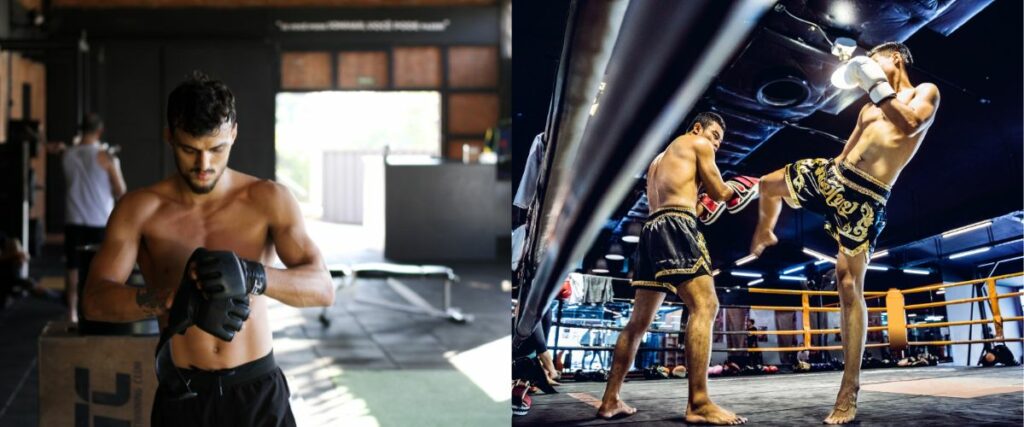MMA is quickly becoming the most prominent combat sport on the planet, and the popularity of Muay Thai is in no small part thanks to that fact. The Thai national sport is an integral part of MMA, but it is also a fantastic sport and martial art in and of itself. But what exactly is the difference between MMA and Muay Thai?
Muay Thai is a striking-only system using all limbs as weapons, while MMA includes all that Muay Thai has but adds wrestling and grappling into the mix. In a direct battle between the two styles, Muay Thai usually wins a stand-up battle, and MMA has the advantage when the rules allow everything.
Each of the two sports has a myriad of intricacies and details that make them what they are. With such a high level of popularity in both, it’s natural to wonder how they compare, and today you’ll find out.
What Is MMA
MMA stands for mixed martial arts. As the name suggests, the sport combines techniques and concepts from many martial arts into a system with its own specifics. The initial idea of MMA was to answer in practice the age-old question of which martial art is the best.
MMA started in the 1980s in Japan but became popular after the first few UFC events in the 1990s. They were no-rule affairs that pitted fighters with different backgrounds against each other.
The sport quickly became a regulated athletic contest with rules, structure, and worldwide organizations. Despite implementing many rules, MMA is still the rawest form of combat sports.
The rules allow striking, wrestling, and grappling, making it a complete package. While all of the techniques “come from” other martial arts, each move and concept must be morphed and adapted to the reality of MMA.
Martial art vs. martial art fights are a thing of the past, and today all fighters have a very diverse skill set that covers all aspects of fighting.
What Is Muay Thai
Muay Thai is a combat sport and martial art from Thailand that emphasizes striking. Like all other centuries-old martial arts, Muay Thai was conceived on the battlefield and was used for unarmed combat.
In time, it was also used for entertainment and ritual events. In the early 1900s, it grew as a form of entertainment. It evolved into its correct form after it came into contact with western boxing in the 1920s.
Muay Thai is the national sport of Thailand and is held in very high regard there. The centuries-old traditions are a beautiful side of Muay Thai that is not found in most combat sports.
Fight events always include traditional rituals like the pre-fight dance called a wai-kru and the music that accompanies each fight, called sarama. Fighters also wear special headbands called mongkhons during the rituals.
Today, Muay Thai is well-developed outside of Thailand, with a competitive scene and many prominent academies worldwide. It is also the striking style of choice for most MMA fighters.
Key Differences Between MMA and Muay Thai

Rules
The rules of a fight sport dictate everything else in the competition. Muay Thai fights allow only striking, including punches, kicks, elbows, and knees, while also awarding domination in the clinch and effective throws and trip techniques.
Matches are fought in a square boxing ring in 5 rounds of 3 minutes each. The match can be won by a knockout, a referee’s stoppage, or, if none of these happens, by the judge’s decision.
MMA allows striking with all body parts, but it also has takedowns and ground fighting that features strikes and submissions. Fights are usually contested in a cage, but a ring can also be used. The rounds are 5 minutes each.
Most fights are 3 rounds, but championship fights and UFC main events are 5 rounds. MMA fights can end with a knockout, referee stoppage, a submission, or by a judge’s decision.
Techniques
Muay Thai has a very distinctive set of instantly recognizable techniques. The traditional rear-foot heavy stance with the hands held very high, the rhythm of the stomping front foot, and the extremely powerful kicking form are among the staple techniques of Muay Thai.
Thai fighters are also masters of elbow strikes and clinch battles. While punching is often quite basic, the rest of Muay Thai’s tools are among the deadliest striking techniques.
MMA includes any techniques that can work within the rules. Boxing punches, Muay Thai kicks and elbows, wrestling takedowns, and BJJ submissions are the most common ” package technique.”
Still, fighters use a variety of other techniques as well. Karate, judo, sambo, taekwondo, and other martial arts also have much to offer MMA.
Equipment
Muay Thai fighters compete in traditional Thai shorts and 10 or 8-ounce boxing gloves. Mouth guards and groin guards are mandatory. Ankle straps are not, but are part of the equipment of every Thai fighter. Like almost all striking styles, Muay Thai fighters fight and train barefoot.
The fighting gloves used in MMA are different from boxing gloves. They are smaller, around 4 oz, and are fingerless to allow effective grappling. MMA fighters also fight barefoot and wear shorts, mouth guards, and groin guards.
Training and Sparring
There is also a big difference in how training is structured. Especially in traditional Thai gyms, training is predominantly done on heavy bags and pads. Clinching plays a significant role, and due to the frequent fighting schedule in Thailand, sparring is usually done very lightly.
The massive difference in comparison with MMA is the absence of weight training. The grappling elements in mixed martial arts require a lot more strength and physical attributes, and strength and conditioning play a considerable part in the preparation of each MMA fighter.
Sparring in MMA and the West is a lot more aggressive. Like in boxing and kickboxing, MMA sparring is often very hard, especially in a fight camp.
This can lead to many injuries, but preparing fighters physically and mentally for a fight is necessary. Thais, on the other hand, can fight as frequently as every week, which removes the need for hard sparring.
MMA vs. Muay Thai For Self-Defense

Without much debate, I can unequivocally say decent MMA or Muay Thai skills will give you a massive advantage over most people in a self-defense scenario.
But MMA has the upper hand in a direct comparison because it includes all Muay Thai and adds many more techniques usable in the real world. Wrestling and BJJ, in particular, are priceless in any real-life situation as they allow you to choose where the fight goes.
On top of that, solid grappling can help you neutralize an assailant without dealing unnecessary damage that can later put you in trouble with the law.
Who Would Win MMA or Muay Thai?
The answer to this question lies in the contest rules between the two. In most cases, the Muay Thai fighter wins a stand-up battle, while the MMA fighter will likely dominate if he can get to the ground. There are quite a few fighting examples that we can look at.
Perhaps the best example is the unique fight between MMA and Muay Thai, which ONE FC entertained. One of the greatest MMA fighters of all time, Demetrious Johnson, fought current Muay Thai world champion Rodtang in a mixed-rules fight.
Mighty Mouse did great in the first round under full Muay Thai rules, but Rodtang was much more comfortable. In the second, the rules were switched to MMA, and the fight went exactly as expected.
Johnson managed to eventually close the distance, secure the back and sink in a rear naked choke that put Rodtang to sleep.
More common are the instances where MMA fighters foray into the world of Thai fighters. Muay Thai is an integral part of MMA, and many fighters are very good at the art of eight limbs. But pure Thai stylists are much more specialized and outclass the MMA fighters heavily.
However, the outcome is not always predetermined. Here are 3 notable fights between Muay Thai and MMA in a striking battle.
MMA vs. Muay Thai: Which Should You Choose
Choosing between MMA and Muay Thai comes down to your personal preferences. Do you want only to strike, or do you want to incorporate all aspects of fighting?
Muay Thai puts a lot of importance on clinching and throwing in addition to striking, which makes it a more complete striking style than, let’s say, boxing or karate. If you want to specialize in a single discipline, Muay Thai is the way.
If you want to have well-rounded unarmed fighting skills, MMA is the best choice. Training in MMA will never get boring as you will have so much to learn.
This can be a positive thing, but it can also be a negative one. Learning so much can be overwhelming, and you may not learn much of anything without enough training time.
When comparing the competitive scene, MMA may offer a bit more exposure, fame, and money due to its global expansion. But Muay Thai has a tremendous competitive scene as well, and not just in Thailand, so you may have a viable career option in both MMA and Muay Thai.
Muay Thai may seem easier on the surface because it has fewer techniques to learn. Still, the level of mastery in these areas is much higher. So make no mistake about it, you will have to pour your heart and soul into it to reach the top of whichever sport you choose.
I advise you to book a few classes in each, see how it goes, and then make a choice. Either way, it’s the correct one.
